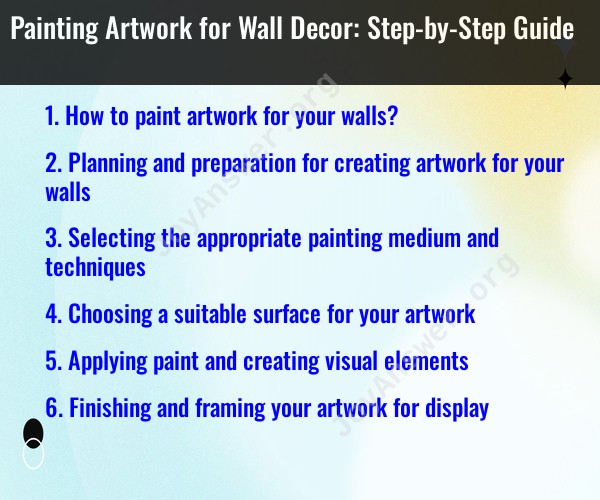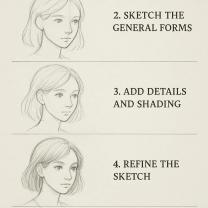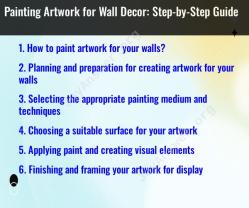How to paint artwork for your walls?
Creating your own painting artwork for wall decor can be a rewarding and enjoyable experience. Here's a step-by-step guide to help you get started:
Step 1: Gather Your Supplies
Collect all the necessary materials:
- Canvas or Art Paper: Choose the size and type of surface you want to paint on.
- Paints: Acrylic or oil paints are commonly used for beginners. Select a variety of colors.
- Paintbrushes: Different sizes and shapes for various details.
- Palette: For mixing and blending colors.
- Palette Knife: Optional for texture and special effects.
- Easel: If you have one, it can make the process more comfortable.
- Water Container: For cleaning brushes if you're using acrylics.
- Palette Paper or Disposable Palette: For easy clean-up.
- Rags or Paper Towels: For wiping brushes or correcting mistakes.
- Apron or Old Clothes: Painting can get messy!
Step 2: Choose a Theme or Concept
Decide on the theme or concept for your artwork. This could be inspired by nature, emotions, abstract shapes, or anything else that resonates with you.
Step 3: Sketch Your Design
Using a pencil, lightly sketch your design on the canvas. This will serve as a guide for your painting.
Step 4: Apply a Base Layer
Cover the canvas with a base layer of paint. This helps set the tone for your artwork and provides a starting point.
Step 5: Layering and Adding Details
Start layering your paint, adding more colors and details as you go. Work from the background to the foreground, allowing each layer to dry before adding the next.
Step 6: Experiment with Techniques
Don't be afraid to experiment with different painting techniques. Try blending, splattering, or using a palette knife for texture.
Step 7: Let it Dry
Allow your artwork to dry completely between layers to avoid smudging or blending unintended areas.
Step 8: Final Touches
Once you're satisfied with your painting, make any final touches or adjustments. Step back and assess your work from a distance.
Step 9: Seal Your Artwork
If you're using acrylics, consider sealing your artwork with a clear varnish or medium to protect it and enhance the colors.
Step 10: Hang and Enjoy
Once your artwork is dry and sealed, hang it on your wall and enjoy your personalized creation!
Remember, the most important thing is to have fun and express yourself. Don't be afraid to make mistakes, as they can often lead to interesting and unique outcomes. Happy painting!
Planning and preparation for creating artwork for your walls
Before embarking on your artistic journey, it's crucial to lay a solid foundation through careful planning and preparation. This will ensure that your artwork aligns with your vision, aesthetic, and the overall ambiance of your space.
Define Your Artistic Goals: Clearly articulate the purpose and mood you want your artwork to evoke. Are you seeking a statement piece that commands attention or a serene and calming addition to your décor?
Gather Inspiration: Immerse yourself in the world of art, exploring galleries, online resources, and nature to find inspiration for your creative expression. Consider colors, textures, patterns, and motifs that resonate with you.
Choose a Focal Point: Identify the central element of your artwork, the element that will draw the viewer's eye first. This could be a striking figure, a bold pattern, or a captivating color contrast.
Sketch Out Your Ideas: Before committing to paint, create rough sketches of your composition to refine your ideas and experiment with different layouts.
Selecting the appropriate painting medium and techniques
The choice of painting medium will significantly impact the style and appearance of your artwork. Explore the following options:
Acrylic Paint: Acrylics are versatile and easy to use, offering a wide range of colors and drying quickly. They can be applied to various surfaces, including canvas, paper, and wood.
Oil Paint: Oil paints are renowned for their rich colors, smooth blending, and long-lasting quality. They require specialized solvents for thinning and cleaning.
Watercolor Paint: Watercolors are known for their delicate transparency and ethereal quality. They require special watercolor paper that can withstand water absorption.
Gouache Paint: Gouache is an opaque water-based paint that offers a matte finish. It is similar to watercolor in terms of technique but produces a more solid and vibrant effect.
Mixed Media: Experiment with combining different painting mediums, such as acrylics and watercolors, to create unique textures and effects.
Once you've chosen your painting medium, research and practice various techniques to enhance your creative expression. Consider exploring layering, blending, glazing, and impasto techniques.
Choosing a suitable surface for your artwork
The choice of surface will depend on the painting medium you select. Here are some common options:
Canvas: Canvas is a traditional and versatile surface for painting, offering a textured base for various mediums.
Watercolor Paper: Watercolor paper is specifically designed to absorb water and prevent warping. It comes in various weights and textures.
Wood Panels: Wood panels provide a smooth and durable surface for painting and can be used with various mediums.
Other Surfaces: Explore unconventional surfaces like fabric, glass, or metal for a unique and personalized touch.
Applying paint and creating visual elements
With your chosen medium and surface prepared, it's time to bring your creative vision to life. Start by applying base coats and creating the foundational elements of your artwork. Then, gradually build up layers of color, texture, and detail.
Color Palette: Choose a harmonious color palette that complements your décor and evokes the desired mood.
Brushwork: Experiment with different brush sizes and techniques to create varied textures and effects.
Composition: Consider the balance and arrangement of visual elements within your artwork.
Details: Add intricate details and embellishments to bring your artwork to life.
Finishing and framing your artwork for display
Once your artwork is complete, allow it to dry thoroughly. Then, consider applying a varnish or sealant to protect the paint and enhance its vibrancy.
- Framing: Select a frame that complements the style and color scheme of your artwork. A well-chosen frame can elevate the overall presentation.
Remember, creating artwork is a journey of self-expression and exploration. Embrace the process, experiment with different techniques, and let your creativity shine through. Your unique artwork will add a personal touch to your home and serve as a reminder of your artistic journey.












